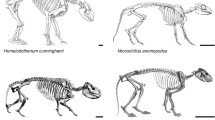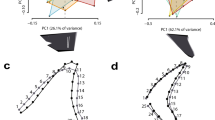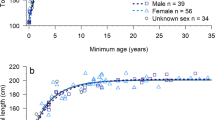Abstract
Baikal seals (Pusa sibirica) are a unique freshwater pinniped that inhabits Lake Baikal in the interior of Eastern Siberia. These seals were critical resources for human groups living along the lake through at least the Holocene. This study develops osteometric methods for assessing Baikal seal body size, including body mass and nose-tail length. This was accomplished through the analysis of biometric and osteometric data for 354 modern Baikal seals. The resulting methods can be expediently used to estimate seal body mass and length. Using these methods, we explore seal use at Sagan-Zaba II, a habitation site on Lake Baikal with deposits spanning much of the past 9000 years. These analyses reveal a general preference for smaller-bodied seals, particularly during the Middle Holocene, and a paucity of larger individuals in the assemblage. Previous ageing of seal remains from Sagan-Zaba II based on incremental structures in seal canines suggested a very similar pattern of seal use. These methods provide useful insights on seal use that complement those already developed for estimating seal age and season of death.










Similar content being viewed by others
Data availability
All data generated or analyzed during this study are included in this published article (and its supplementary information files).
References
Albarella U (2002) ‘Size matters’: how and why biometry is still important in zooarchaeology. In: Dobney K, O’Connor T (eds) Bones and the Man: Studies in Honour of Don Brothwell. Oxbow Books, Oxford, pp 51–62
Bettinger RL (2009) Hunter-gatherer foraging: five simple models. Left Coast Press, Walnut Creek
Borella F, L’heureuxGrandi GLMF (2016a) Osteometric analysis of South American sea lions (Otaria flavescens) pups from Patagonia. An Assessment of Their Use as Indicators for Seasonality in Archaeological Sites. Int J Osteoarchaeol 26:28–41. https://doi.org/10.1002/oa.2392
Borella F, L’Heureux GL, Vales DG, Crespo EA (2016b) Exploring body size of modern South American fur seal (Arctocephalus australis) for osteometric studies in zooarchaeological remains from northern Patagonia, Argentina. Quat Int 391:82–89. https://doi.org/10.1016/j.quaint.2015.07.038
Boessneck J, von den Driesh A (1978) The significance of measuring animal bones from archaeological sites. In: Meadow RH, Zeder MA (eds) Approaches to Faunal Analysis in the Middle East, Peabody Museum of Archaeology and Ethnology Bulletin no. 2. Harvard University, Cambridge, pp. 25–39.
Braje, TJ, Rick TC (2011) Human impacts on seals, sea lions, and sea otters: Integrating archaeology and ecology in the northeast Pacific. University of California Press, Berkeley. https://doi.org/10.1525/9780520948976
Brassey CA (2016) Body-mass estimation in paleontology: a review of volumetric techniques. Paleontol Soc Papers 22:133–156. https://doi.org/10.1017/scs.2017.12
Breslawski RP, Byers DA (2015) Assessing measurement error in paleozoological osteometrics with bison remains. J Archaeol Sci 53:235–242. https://doi.org/10.1016/j.jas.2014.10.001
Buck CE, Christen JA, James GN (1999) BCal: an On-line Bayesian radiocarbon calibration tool. Internet Archaeol. 7. https://doi.org/10.11141/ia.7.1
Damuth J, MacFadden BJ (eds) (1990). Cambridge University Press, Cambridge
Ducos P (1968) L’origine des animaux domestiques en Palestine. Bordeux, Delmas.
Ericson GP, Storå J (1999) A manual to the skeletal measurement of the seal genus Halichoerus and Phoca (Mammalia: Pinnipedia). Department of Zoology, Swedish Museum of Natural History, Stockholm, Sweden
Etnier MA (2002) The effects of human hunting on northern fur seal (Callorhinus ursinus) migration and breeding distributions in the Late Holocene. Ph.D. dissertation, University of Washington, Seattle
Etnier MA (2004) Reevaluating evidence of density-dependent growth in northern fur seals (Callorhinus ursinus) based on measurements of archived skeletal specimens. Can J Fish Aquat Sci 61:1616–1626. https://doi.org/10.1139/f04-090
Etnier MA (2007) Defining and identifying sustainable harvests of resources: archaeological examples of pinniped harvests in the Eastern North Pacific. J Nat Conserv 15:196–207. https://doi.org/10.1016/j.jnc.2007.04.003
Gifford-Gonzalez D (2011) Holocene Monterey Bay fur seals. Distribution, dates, and ecological implications. In: Braje TJ, Rick TC (eds) Human impacts on seals, sea lions, and sea otters: Integrating archaeology and ecology in the northeast Pacific. University of California Press, Berkeley, pp 221–242
Glykou A (2014) Late Mesolithic-Early Neolithic Sealers: a case study on the exploitation of marine resources during the Mesolithic-Neolithic transition in the south-western Baltic Sea. Internet Archaeol 37. https://doi.org/10.11141/ia.37.7
Kahle P, Rolvien T, Kierdorf H et al (2019) Age-related changes in size, bone microarchitecture and volumetric bone mineral density of the mandible in the harbor seal (Phoca vitulina). Plos One 14:e0224480. https://doi.org/10.1371/journal.pone.0224480
Kunnasranta M, Niemi M, Auttila M et al (2021) Sealed in a lake — biology and conservation of the endangered Saimaa ringed seal: a review. Biol Conserv 253:108908. https://doi.org/10.1016/j.biocon.2020.108908
Losey RJ, Bazaliiskii VI, Garvie-Lok S et al (2011) Canids as persons: Early Neolithic dog and wolf burials, Cis-Baikal, Siberia. J Anthropol Archaeol 30:174–189. https://doi.org/10.1016/j.jaa.2011.01.001
Losey RJ, Nomokonova T (eds) (2017) The Holocene zooarchaeology of Cis-Baikal, Siberia. German Archaeological Institute, Berlin
Losey RJ, Nomokonova T, Kharinskii AV, Emel’ianova IuA (2017a) Baikal’skoe III. In: Losey RJ, Nomokonova T (eds) Holocene zooarchaeology of Cis-Baikal, Siberia. German Archaeological Institute, Berlin, pp 105–120
Losey RJ, McLachlin K, Nomokonova T et al (2017b) Body mass estimates in dogs and North American gray wolves using limb element dimensions. Int J Osteoarch 27:180–191. https://doi.org/10.1002/oa.2528
Losey RJ, Nomokonova T, Savel’ev NA (2016) Humans and animals at Bugul’deika II, a Trans-Holocene habitation site on the shore of Lake Baikal, Russia. Quat Int 419:62–73. https://doi.org/10.1016/j.quaint.2014.08.021
Losey RJ, Osipov B, Sivakumaran R et al (2015) Estimating body mass in dogs and wolves using cranial and mandibular dimensions: application to Siberian canids. Int J Osteoarch 25:946–959. https://doi.org/10.1002/oa.2386
Losey RJ, Waters-Rist AL, Nomokonova T, Kharinskii AA (2017c) A second mortuary hiatus on Lake Baikal in Siberia and the arrival of small-scale pastoralism. Sci Rep 7:2319. https://doi.org/10.1038/s41598-017-02636-w
Lyman RL (1989) Seal and sea lion hunting: a zooarchaeological study from the southern Northwest Coast of North America. J Anthropol Archaeol 8:68–99. https://doi.org/10.1016/0278-4165(89)90007-X
Lyman RL (1992) Prehistoric seal and sea-lion butchering on the southern northwest coast. Amer Antiq 57:246–261. https://doi.org/10.2307/280730
Lyman RL (2006) Identifying bilateral pairs of deer (Odocoileus sp.) bones: how symmetrical is symmetrical enough? J Archaeol Sci 33:1256–1265. https://doi.org/10.1016/j.jas.2006.01.002
Lyman RL, Savelle JM, Whitridge P (1992) Derivation and application of a meat utility index for phocid seals. J Archaeol Sci 19:531–555. https://doi.org/10.1016/0305-4403(92)90027-Z
Lyman RL, VanPool TL (2009) Metric data in archaeology: a study of intra-analyst and inter-analyst variation. Am Antiq 74:485–504. https://doi.org/10.1017/S0002731600048721
Meadow RH (1999) The use of size index scaling techniques for research on archaeozoological collections from the Middle East. In: Becker C, Manhart H, Peters J, Schibler J (eds) Historia Animalium ex Ossibus: Festschrift für Angela von den Driesch, Rahden: Verlag Marie Leidorf GmbH, pp. 285– 300
Monks GG (2005) The exploitation and cultural importance of sea mammals. Proceedings of the 9th ICAZ conference, Durham 2002. Oxbow Books, Oxford
Nomokonova T, Losey RJ, Goriunova OI et al (2015) A 9,000 Year History of Seal Hunting on Lake Baikal, Siberia: The Zooarchaeology of Sagan-Zaba II. PLOS ONE 10:e0128314. https://doi.org/10.1371/journal.pone.0128314
Nomokonova T, Losey RJ, Goriunova OI, Weber AW (2013a) A freshwater old carbon offset in Lake Baikal, Siberia and problems with the radiocarbon dating of archaeological sediments: Evidence from the Sagan-Zaba II site. Quat Int 290–291:110–125. https://doi.org/10.1016/j.quaint.2012.06.007
Nomokonova TIu, Losey RJ, Goriunova OI, Bazaliiskii VI (2014) Holocene seal imagery in the Lake Baikal region of Eastern Siberia. Archaeol Ethnog Anthropol Eurasia 42(3):21–28
Nomokonova T, Losey RJ, Iakunaeva VN et al (2013b) People and seals at Siberia’s Lake Baikal. Etnobiol 33:259–280. https://doi.org/10.2993/0278-0771-33.2.259
Nomokonova T, Losey RJ, Weber A et al (2010) Late Holocene subsistence practices among Cis-Baikal pastoralists, Siberia: zooarchaeological insights from Sagan-Zaba II. Asian Perspect 49:157–179
Packard GC, Boardman TJ, Birchard GF (2009) Allometric equations for predicting body mass of dinosaurs. J Zool 279:102–110. https://doi.org/10.1111/j.1469-7998.2009.00594.x
Palo JU, Väinölä R (2006) The enigma of the landlocked Baikal and Caspian seals addressed through phylogeny of phocine mitochondrial sequences. Biol J Linnean Soc 88:61–72. https://doi.org/10.1111/j.1095-8312.2006.00607.x
Pastukhov VD (1969a) Kraniometricheskaia kharakteristika Baikal’skoi nerpy (Pusa sibirica; Pinnipedia, Mammalia). Zoologicheskii Zhurnal XLVIII 5:722–733
Pastukhov VD (1969b) Nastuplenie polovoi zrelosti u samok Baikal’skoi nerpy. Morskie Mlekopitaiushchie. Nauka, Moskva, pp 127–135
Pastukhov VD (1993) Nerpa Baikala: Biologicheskie Osnovy Ratzional’nogo Ispol’zovaniia i Okhrana Resursov. Nauka, Novosibirsk
Petrov EA, Voronov EA, Egorova LI et al (1997a) Polovosrastnaia struktura i reproduktivnyi potentsial populiatsii Baikal’skoi nerpy Pusa sibirica (Pinnipedia, Phocidae). Zool Zhurnal 76(6):743–749
Petrov EA, Voronov EA, Ivanov MK (1997b) Chislennost’, raspredelenie priploda i promysel populiatsii Baikal’skoi nerpy (Pusa sibirica). Zool Zhurnal 76(7):858–864
Petrov EA (1999) Sovremennoe sostoianie populiatsii Baikal’skoi nerpy (Pusa sibirica, Pinnipedia, Phoicidae): lineino-vesovye kharakteristiki. Zool Zhurnal 78(9):1117–1124
Porter AMW (2002) Estimation of body size and physique from hominin skeletal remains. Homo 53:17–38. https://doi.org/10.1078/0018-442x-00036
Power G, Gregoire J (2011) Predation by freshwater seals on the fish community of lower seal lake, Quebec. J Fisheries Board Can. https://doi.org/10.1139/f78-135
Reitz EJ, Cordier D (1983) Use of allometry in zooarchaeological analysis. In: Grigson C, Clutton-Brock J (eds) Animals and Archaeology: 2. Shell Middens, Fishes and Birds, BAR International Series 183, Oxford, pp. 237–252
Sasaki H, Numachi K, Grachev MA (2003) The origin and genetic relationships of the Baikal seal, Phoca sibirica, by restriction analysis of mitochondrial DNA. J Zool 20:1417–1422. https://doi.org/10.2108/zsj.20.1417
Storå J (2000) Skeletal development in grey seal Halichoerus grypys, the ringed seal phoca hispida botnica, the harbour seal phoca vitulina vitulina, and the harp seal phoca groendlandica: epiphyseal fusion and life History. Archaeozool 11:199–222
Storå J (2001) Reading bones. Stone age hunters and seals in the Baltic. Stockholm Studies in Archaeology 21. Doctoral dissertation, Stockholm University
Storå J, Ericson PGP (2004) A prehistoric breeding population of harp seals (Phoca groenlandica) in the Baltic Sea. Mar Mam Sci 20:115–133. https://doi.org/10.1111/j.1748-7692.2004.tb01143.x
Waters Rist AL, Lieverse AR, Novikov AG et al (2021) Spatial and temporal differences in Late Neolithic Serovo to Early Bronze Age Glazkovo forager diet in Lake Baikal’s Little Sea Microregion. Siberia. Archaeol Res Asia 25:100235. https://doi.org/10.1016/j.ara.2020.100235
Weber AW (2020) Middle Holocene hunter–gatherers of Cis-Baikal, Eastern Siberia: Combined impacts of the boreal forest, bow-and-arrow, and fishing. Archaeol Res Asia 24:100222. https://doi.org/10.1016/j.ara.2020.100222
Weber AW, Bettinger R (2010) Middle Holocene hunter-gatherers of Cis-Baikal, Siberia: An overview for the new century. J Anthropol Archaeol 29:491–506. https://doi.org/10.1016/j.jaa.2010.08.002
Weber AW, Ramsey CB, Schulting RJ et al (2021) Middle Holocene hunter–gatherers of Cis-Baikal, Eastern Siberia: chronology and dietary trends. Archaeol Res Asia 25:100234. https://doi.org/10.1016/j.ara.2020.100234
Weber A, Goriunova OI, Konopatskii AK (1993) Prehistoric seal hunting on Lake Baikal: methodology and preliminary results of the analysis of canine sections. J Archaeol Sci 20:629–644. https://doi.org/10.1006/jasc.1993.1038
Weber A, Katzenberg MA, Schurr TG (eds) (2010) Prehistoric hunter-gatherers of the Baikal region, Siberia. University of Pennsylvania Museum of Archaeology and Anthropology, University of Pennsylvania Press, Philadelphia
Weber AW, Link DW, Goriunova OI, Konopatskii AK (1998) Patterns of prehistoric procurement of seal at Lake Baikal: a zooarchaeological contribution to the study of past foraging economies in Siberia. J Archaeol Sci 25:215–227. https://doi.org/10.1006/jasc.1997.0235
White JA, Schulting RJ, Lythe A et al (2020) Integrated stable isotopic and radiocarbon analyses of Neolithic and bronze age hunter-gatherers from the Little Sea and Upper Lena micro- regions, Cis-Baikal, Siberia. J Archaeol Sci 119:105161. https://doi.org/10.1016/j.jas.2020.105161
Funding
Funding for this research was provided by the Social Sciences and Humanities Research Council of Canada grants #412–2005-1004 and the state assignment of the Vinogradov Institute of Geochemistry SB RAS (project # 0284–2021-0003).
Author information
Authors and Affiliations
Contributions
R.L., T.N., M.P., and A.H. wrote the manuscript. A.N., O.G., and A.W. provided data for the manuscript. A.W. provided funding for the research. All authors reviewed the manuscript.
Corresponding author
Ethics declarations
Competing interests
The authors declare no competing interests.
Conflict of interest
The authors declare no competing interests.
Additional information
Publisher's Note
Springer Nature remains neutral with regard to jurisdictional claims in published maps and institutional affiliations.
Supplementary Information
Below is the link to the electronic supplementary material.
Rights and permissions
Springer Nature or its licensor (e.g. a society or other partner) holds exclusive rights to this article under a publishing agreement with the author(s) or other rightsholder(s); author self-archiving of the accepted manuscript version of this article is solely governed by the terms of such publishing agreement and applicable law.
About this article
Cite this article
Losey, R.J., Nomokonova, T., Pastukhov, M.V. et al. A body size approach to understanding Holocene seal hunting at Lake Baikal in Siberia. Archaeol Anthropol Sci 15, 49 (2023). https://doi.org/10.1007/s12520-023-01753-0
Received:
Accepted:
Published:
DOI: https://doi.org/10.1007/s12520-023-01753-0




